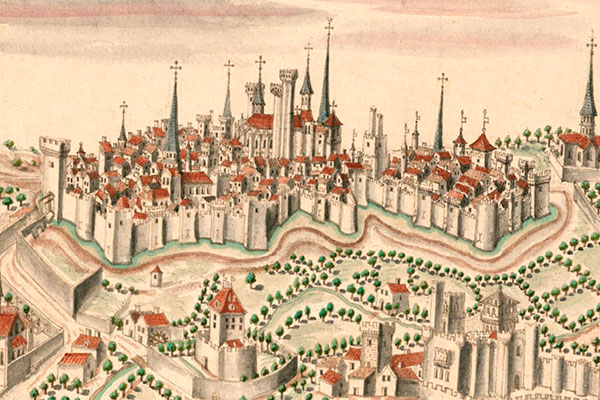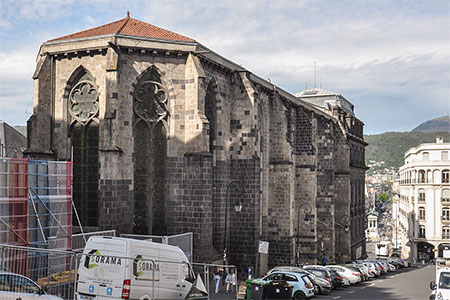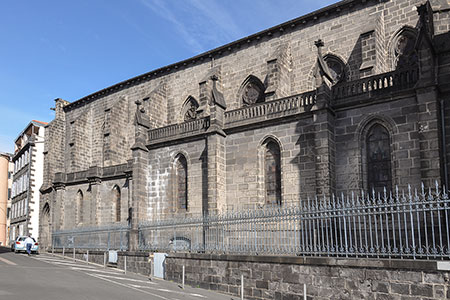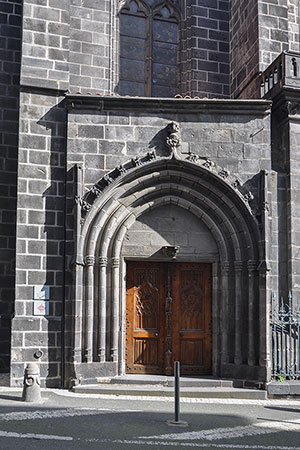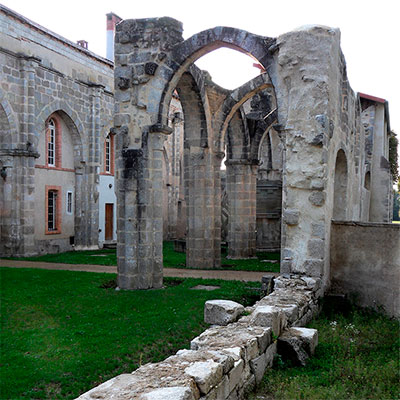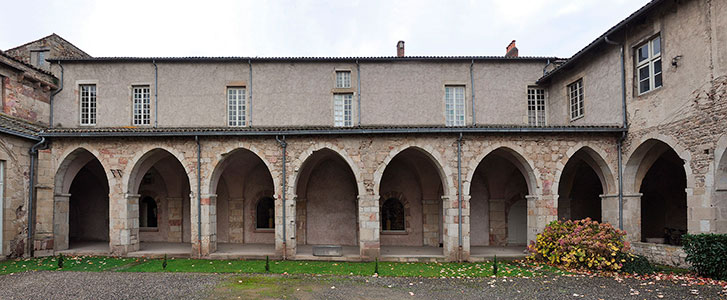Beaurepaire / Franciscans of Clarmont / Cordeliers-Vieux
(Clermont-Ferrand, Puy-de-Dôme)
A Franciscan convent is said to have been founded in 1224 at Montferrand, at a very early stage in the history of the order. Before 1241, the Friars Minor settled in Clermont, first at the site of Beaurepaire, where a chapel still survives. In 1263, the community moved to another location within the city walls, thanks to the intervention of Bernard III de la Tour († 1286), who gave the friars a ruined castle where the new convent would be built.
Following this transfer, Beaurepaire passed to the chapter of Clermont Cathedral. The church of the new convent was consecrated in 1284 by Guy de la Tour, bishop of Clermont. The house remained closely linked to the lords of La Tour, many of whom were buried in its church. In 1515, the convent was reformed and adopted the Observant rule, despite opposition from the original Conventual community. After the Revolution, in 1791, the property was taken over by the state and the church became the departmental archives. It is the only surviving building of the former Franciscan convent.
- AUDIGIER (1888). L’église et le couvent des Cordeliers de Clermont. Revue d'Auvergne, vol. 5. Clermont-Ferrand
- BOURGUIGNON, Claire (2020). Les espaces conventuels des ordres mendiants dans les « petites villes » du diocèse de Clermont (XIIIe-XVe siècles). Siècles, núm. 48
- LEMAÎTRE, Henry (1927). Géographie historique des établissements de l'ordre de Saint François en Bourgogne du XIII au XIX siècle. Revue d’histoire franciscaine. Vol. IV. París: Vrin
- RANQUET, H. du (1911). Chapelle de Beaurepaire ou des Cordeliers-Vieux. Chapelle des Cordeliers ou Salle des Archives. Bulletin historique et scientifique de l'Auvergne. Clermont-Ferrand
- TARDIEU, Ambroise (1870). Histoire de la ville de Clermont-Ferrand. Moulins: Desrosiers
Les Carmes de Clermont / Saint-Genès des Carmes
(Clermont-Ferrand, Puy-de-Dôme)
The Carmelite convent of Clermont was founded in 1288 thanks to the support of Guillaume de Brioude and Bernard de Riom. The former acquired the land on which the convent was to be built and later became its prior. In 1329, a new church was constructed on the same site, which until 1280 had been occupied by the Friars of the Sack (Brothers of the Penitence), an order suppressed at that time. Because of its proximity to the parish church of Saint-Genès, which had existed since the 7th century under the patronage of Saint-Symphorien, the Carmelites faced opposition from the parish clergy. This caused them numerous difficulties, including violent conflicts, which continued until the mid-15th century.
The construction of the conventual church was slow and was not completed until its consecration in 1472. The convent was suppressed during the Revolution, and in 1791 it became public property. The church, a single-nave building with lateral chapels, is the only surviving part of the conventual complex and shows the typical layout of mendicant orders. After the old parish church of Saint-Genès disappeared during the Revolution, the Carmelite church took over its role and adopted its dedication.
- BOUILLET, Jean-Baptiste (1840). Église de St-Genès-les-Carmes de Clermont et ses vitraux. Tablettes historiques de l'Auvergne, vol. 1. Cletmont-Ferrand: Perol
- BOURGUIGNON, Claire (2019). Architecture et décor des couvents mendiants dans le Massif central. Monastères et couvents de montagne. París: Comité des travaux historiques et scientifiques
- TARDIEU, Ambroise (1870). Histoire de la ville de Clermont-Ferrand. Moulins: Desrosiers
The Cistercian abbey of Montpeyroux was founded in 1126 by Foulques de Jaligny, lord of Puy-Guillaume, with the support of the Abbey of Bonnevaux (Isère). The founder donated the land required for the new establishment and began its construction. The first known abbot of this house was Johannes. In 1137, the Benedictine monastery of Notre-Dame de Bellaigue joined the Cistercian Order, placing itself under Montpeyroux’s authority. In 1175, the monastery church was consecrated by Bishop Ponce de Polignac, a former abbot of Clairvaux (Aube).
Affiliation of Montpeyroux
According to Originum Originum Cisterciensium (L. Janauschek, 1877)During the 15th century, the monastery was occupied and plundered, forcing the monks to flee temporarily. In 1685 it was severely damaged by fire, and when the Revolution came, reconstruction work was still unfinished. Some medieval architectural remains survive alongside 17th- and 18th-century buildings.

Armorial général de France (18th century)
Bibliothèque nationale de France
- BEAUNIER, Dom (1912). Abbayes et prieurés de l'ancienne France. Vol. 5. Bourges. Abbaye de Ligugé
- BRANCHE, Dominique (1842). L'Auvergne au moyen âge. Monastères. Vol. 1. Clermont-F.: Thibaud-L.
- DU TEMS, Hugues (1775). Le clergé de France, vol. III. París: Brunet
- JANAUSCHEK, Leopoldus (1877). Originum Cisterciensium. Vol. 1. Viena
- MATUSSIÈRES, A. (1850). Notice sur l'abbaye de Montpeyroux. Annales scientifiques, littéraires et industrielles de l'Auvergne, vol. 23
- SAINT-MAUR, Congregació de (1720). Gallia Christiana in provincias ecclesiasticas distributa. Vol. 2. París: Typographia Regia
Celsinianum / Soucilanges / St-Pierre-St-Paul de Sauxillanges
(Sauxillanges, Puy-de-Dôme)
The monastery of Sauxillanges was probably founded in 927 by Count Acfred of Aquitaine, on the site where one of his predecessors, William I, had already established a church. That first monastic community was likely a regular canonry, but by the middle of the same century it had become a Cluniac house. The first known reference to this connection dates from 944, and it is likely that the incorporation into Cluny took place during the episcopate of Étienne II, bishop of Clermont between 942 and 984.
Sauxillanges became one of the most important monasteries in Auvergne, with a large community, although from 1062 it held the rank of priory. The church was consecrated in 1095 by Pope Urban II. From 1483 the house came under the control of commendatory priors and, in the following centuries, fell into decline. The monks of Cluny remained there until the Revolution. From 1840 it was used as an educational institution, a function it retained until 1904. Today, the few surviving remains of the monastery are privately owned. Some Romanesque elements have been preserved, but most of the surviving structures date from the 15th and 16th centuries. Notable features include part of the cloister and the priory chapel known as Notre-Dame du Bois.
- BEAUNIER, Dom (1912). Abbayes et prieurés de l'ancienne France. Vol. 5. Bourges. Abbaye de Ligugé
- BERGER, Jean; i altres (2022). Une refondation de l’évêque d’Auvergne Étienne II en Lembron et l’implantation des clunisiens en Auvergne à Sauxillanges: un dossier documentaire complexe. Éditions de la Sorbonne
- BUC, Philippe (1998). Les débuts de Sauxillanges : à propos d’un acte de 927. Bibliothèque de l'école des chartes, vol. 156
- COSSE, Étienne-Joseph (1857). Souvenirs de voyage, ou Les vacances en Auvergne : itinéraire du Puy-de-Dôme. Clermont-Ferrand: Thibaud
- DONIOL, Henri; ed. (1861). Cartulaire de Sauxillanges. Mémoires de l'Académie des sciences, belles-lettres et arts de Clermont-Ferrand, vol. III. Clermont-Ferrand: Thibaud
- SAINT-MAUR, Congregació de (1720). Gallia Christiana in provincias ecclesiasticas distributa. Vol. 2. París: Typographia Regia
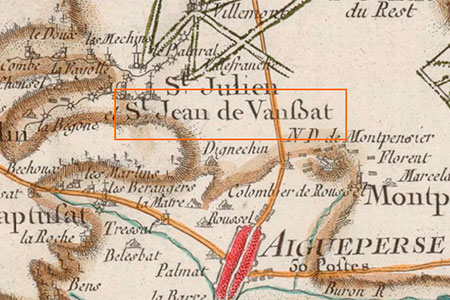
Detail of Carte générale de la France
Cassini de Thury (1776)
Bibliothèque nationale de France
This ancient monastery was founded by Saint Brachio (or Braque, †576), a disciple of Saint Aemilian the Hermit. Brachio received land at Vensat as a donation, where he built a monastery dedicated to Saint Saturnin. He also founded two monasteries near Tours and took part in the reform of the Abbey of Menat, established shortly before and then suffering a period of decline due to a relaxation of discipline.
Later, Saint-Saturnin de Vensat became a priory dependent on the monastery of Menat. The monastic church was in poor condition in the 19th century and was rebuilt next to the former one; by that time, it was already dedicated to Saint-Jean.
- BRANCHE, Dominique (1842). L'Auvergne au moyen âge. Monastères. Vol. 1. Clermont-F.: Thibaud-L.
- LONGNON, Auguste (1878). Géographie de la Gaule au VIe siècle. París: Hachette
- MITTON, F. (1935). Église de Menat. Bulletin de la Société d'émulation du Bourbonnais. Vol. 38
- ROUGEYRON, Guillaume (1858). Histoire et légendes de l’abbaye de Menat. Clarmont: L. Catholique
